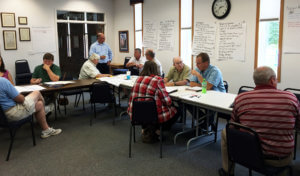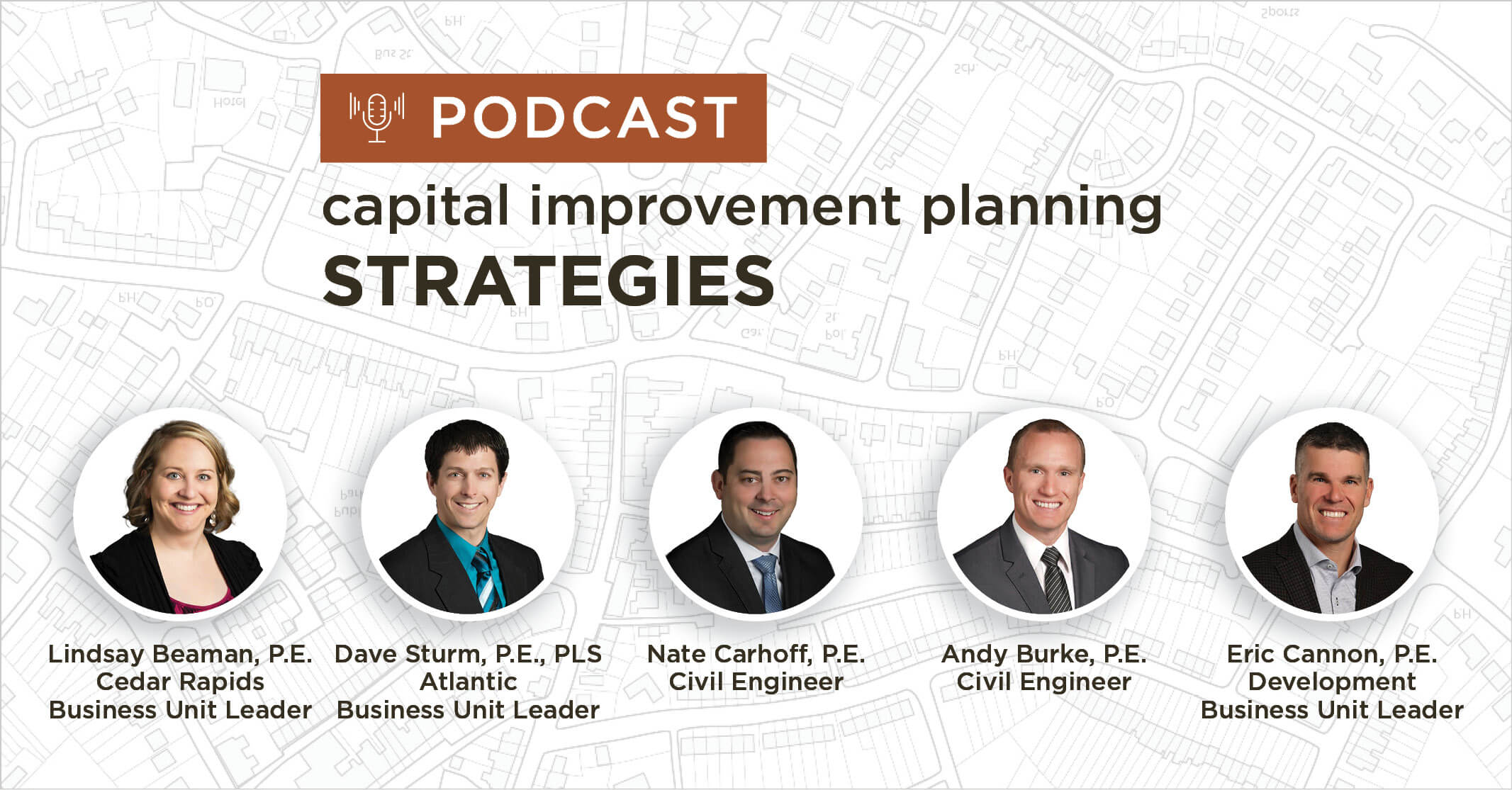Strategic Capital Improvement Program (CIP) Planning
Snyder & Associates’ municipal experts Lindsay Beaman, P.E., Dave Sturm, P.E., PLS, Nate Carhoff, P.E., Andy Burke, P.E., and Eric Cannon, P.E. outline a detailed approach to Capital Improvement Program (CIP) planning, including strategies to help prioritize your goals then identify funds to reach them.
Beginning with preparation for the planning process, which includes budgeting and identifying financial resources. Then moving into project prioritization and scoping to help determine whether maintenance or replacement is appropriate for aging assets. Concluding with one of the most important elements, recommendations for gathering community and key stakeholders feedback.
Podcast Agenda
- Preparing for Capital Improvement Program Planning (0:49)
- Determining Budgets & Identifying Financial Resources (2:04)
- Developing Priorities for Capital Improvement Planning (4:01)
- Evaluating Maintenance Verse Replacement/Reconstruction (6:23)
- Involving the Public in Prioritizing & Planning (11:12)
- Coordinating & Communicating with a Variety of Stakeholders (16:50)
- Capital Improvement Program Planning During Economic Uncertainty (19:14)

Lindsay Beaman, P.E.
Cedar Rapids Business Unit LeaderLindsay Beaman, P.E.
Cedar Rapids Business Unit LeaderWater System Analysis & Planning, Design & Construction, Wastewater Treatment Design, Municipal Engineering

Dave Sturm, P.E., PLS
Atlantic Business Unit LeaderDave Sturm, P.E., PLS
Atlantic Business Unit LeaderMunicipal Engineering, Street Design, Trail Planning and Design, Site Planning, Land Development, Airport Improvements, Project Management

Nathan Carhoff, P.E.
Civil EngineerNathan Carhoff, P.E.
Civil EngineerHighway and Street Design, Transportation Planning, Municipal Engineering, Funding Procurement, Trail Design, Pavement Management

Andy Burke, P.E.
Civil EngineerAndy Burke, P.E.
Civil EngineerRoadway and Highway Design, Intersection Design, Municipal Engineering, Trail Design, Project Management

Eric Cannon, P.E.
Development Business Unit LeaderEric Cannon, P.E.
Development Business Unit LeaderSubdivision and Site Development Engineering, Stormwater Modeling, Master Planning, Municipal Engineering, Construction Assistance
Preparing for Capital Improvement Program Planning
Lindsay Beaman (0:21)
Hi, and thank you for coming to today’s podcast with Snyder & Associates. My name is Lindsay Beaman, and today we’re going to be discussing CIP planning, that’s capital improvement planning, with some of our municipal experts within our company. We’ll ask them some questions so we can have a general conversation about how Snyder & Associates can help you with capital improvement planning as we enter budgeting and planning season.
I want to start with Dave Sturm today. Dave, we’re kicking off into the budget planning season. What are some of the things that you do to help your clients prepare for planning this time of year?
Dave Sturm (0:49)
Thanks, Lindsay. A lot of the things we do to help clients plan for their projects is we start looking at what their needs are going forward for the next year. We look at what they have for budget requirements. Most of our clients are repeat clients, so we kind of have a good idea already what they’re looking to do over the next couple of years. Usually, we just have sit-down meetings, look at their plan going forward, and we try to match projects to their budgets. Because out here in Southwest Iowa, we have a lot of small clients with pretty small budgets. We just try to help them fit their needs to what they have for money.
We also look at what is available through our local funding agencies as well. Through Community Development Block Grant (CDBG) projects, U.S. Department of Agriculture (USDA) funding, and try to assist the cities with getting grants and loans to aid them in the completion of those projects.
Lindsay Beaman (1:32)
Andy, maybe you could help me understand what are some of those projects that they might be looking to do and how might you pick and choose what are priorities?
Andy Burke (1:39)
Well, I think the clear variable there is budget, as Dave noted before. It’s the largest variable in that decision-making process. If they do have tight budget constraints making the prioritizing maintenance versus replacement or reconstruction decision is a key component to that. I think walking through that process with the clients to find the most value or the biggest bang for your buck in making the best decision.
Determining Budgets & Identifying Financial Resources
Lindsay Beaman (2:04)
So, in talking about funding. Nate, can you weigh in on how – there’s not an unlimited amount of money available. Are there ways for a city to help understand what they’ve got to work with?
Nate Carhoff (2:15)
I think that a very important part of the planning process is understanding the budget and where the money is coming from. In a lot of the communities we work with, we try to put that financial planning into the project planning. We like to take a look at the property tax, revenues, debt, and service projections. A lot of that stuff is all through the county’s auditor, it’s publicly available data. We can use what their tax base is to then do projections on what their general obligation (GO) bond capacity would be. We can take a look at what their existing GO bonds are and their retirement schedule. Just to kind of give them a better idea of what debt they have, when that debt will be retired, and then when they can take on more debt.
The caveat to that is, we are engineers. We know what we know when it comes to infrastructure work. We always like to advise our clients to engage their financial advisor or their bond counsel to check our work or verify our assumptions are in the ballpark. Of course, when it comes to an actual project or issuing bonds, that’s where we kind of take a step back and let the community or the city’s bond counsel step in and take over from there.
Eric Cannon (3:24)
I think another thing here locally, being in the Des Moines Metro, is that development drives a lot of these priorities and needs. If you have a developer that’s willing to come in and develop 80 or 100 acres, but they need a water main extension, they need a road brought to them or upgraded, or something like that, we’ll see where cities will kind of shift those priorities around based on really the needs of the community and the development opportunities to grow that tax base. So, priorities can be a moving target.
I’m not involved a lot with setting those priorities. We’re not the decision-makers. We’re the ones bringing the information to the table, providing cost estimates, concepts, and stuff like that, and letting the policymakers steer that ship when it comes to priorities.
Developing Priorities for Capital Improvement Planning
Lindsay Beaman (4:01)
Thanks, Eric. That’s kind of where I was going to go next with my questions is. As the experts here in an engineering community, we know how to take the available funding, or look for the available funding, and place it on the priorities of a community. How does that community start to sit down and make some priorities? I think if you’d ask many of our clients, they’d say we need to do a lot of work, and there’s never going to be enough to catch up, or maybe there are just more goals for the council members than is possible for the community to afford. How do we help them to break that down, maybe planning sessions or other ways to justify those priorities?
Nate Carhoff (4:35)
We always start with the department heads and what their highest goals are, our priorities are. We’ll sit down with public works or wastewater, streets department, parks department, and then we’ll bring in members from the city leadership; the mayor, a couple of council members, administrators, and then also some community members that are chosen by the city leadership to help kind of steer the priorities. We start with the huge dollar amount of what everybody wants, and then we kind of whittle that down into what the community can afford going forward on a year-by-year or a five-year type basis.
I think if a community hasn’t done a Capital Improvements Plan in a while, there’s going to be some sticker shock. One of our communities hadn’t done a plan in a while, and we ended up identifying $15 million worth of improvements after it was all said and done, all the way through all the departments and all the equipment replacements. That was quite a shock to them. Then we went through and identified funding sources and what the community needed to do. After we got through all of that process, it’s not that scary at the end of it. That $15 million in projects – well, some of those are completely wishful thinking and are put off into year five or year ten, and let’s focus on what can be done this year, what needs to be done this year, next year, and roll up our sleeves and get to work.
Andy Burke (5:59)
I think a key component there is to update that. That’s kind of an active or a live document, and updating that CIP either annually or whatever the client chooses is important, too, because we all understand that the funding and the budgets are flexible and fluid from our clients. One year’s CIP might look a little bit different from the next year’s, just based on some of the projects or priorities that might pop up during any particular year.
Evaluating Maintenance Verse Replacement/Reconstruction
Eric Cannon (6:23)
So one of the communities we’re involved with, it’s kinda funny. Back in the day, 10 or 12 years ago, when we first started working with them, they had a dry erase board down in the basement that everybody just wrote out projects on there that kind of was their wish list, and that was their CIP. When we got involved, we started putting booklets together for them, where we did an organized list. We didn’t necessarily prioritize it, but we just kind of gave them that list of projects. We had a cost estimate with it and a concept plan graphic on an aerial, which I think helped them understand the individual projects.
They could see the value of what each one was. Then it gets into those planning sessions where you’re meeting with council members, and they’re having those work sessions to say, hey, I’m getting a lot of feedback from the community about all these potholes we’ve got or all these old streets that are busted up. We need to look at some patching projects over here and not let them get to the point where you gotta go replace them all because the streets are so far gone.
So forward-thinking and understanding what those needs are to the community and to avoid the big-ticket items. Are there some interim things that we can do maintenance-wise that will stretch out the life of the infrastructure that they do have?
Lindsay Beaman (7:24)
Eric started to touch on this, and I wanted to hear more about how you can do a streets maintenance project, but if you wait five more years you might end up doing a street replacement project. If you can invest now, you’re going to save a lot more money than investing later. Can we talk more about how that impacts not only streets but water, sewer, infrastructure throughout parks? That’s always an ongoing conversation and maybe something we need to help express more to our clients?
Dave Sturm (7:48)
Yeah, that’s something I can address a little bit. Most of our clients don’t see value in that type of rehab and maintenance work, even though we know there is a lot of value to that. They say, why should I put money into this street that’s not too bad? When I’ve got these other streets that are complete junk and in need of replacement? We try to guide them down the right path to do some maintenance work and to have the longevity of their streets last longer when they’re not in complete replacement condition yet.
Eric Cannon (8:15)
Yeah, and I think some of that technology that’s kind of come to the forefront here, like partial depth patching, the joint replacement that we can do. There’s not a lot of that that’s commonly known to some of the public works folks or some of those smaller communities. We can come in and say here are some options that we can do that’s not necessarily a band-aid. It’s an investment that you’re making. They see the streets going bad, and they’re like, well, look at all these joints that are terrible, let’s just replace it. Well, we can look at a partial depth patch in the joints that are going to extend the life because the panels are good. There’s no failure in the subgrade. The pavement itself still got a lot of life left to it. So, I think that’s where we can take some of that technology and those ideas that we have from being such a large firm and bring that down to really everybody to help save money and buy more time.
Nate Carhoff (9:01)
On that note, too, Eric, I was just thinking about some of the maintenance opportunities that a lot of cities neglect, and one of them is sealing up those joints. It’s something that we always put on our capital improvements planning as maintenance activities that sometimes gets forgotten, but that can help extend the life of the concrete pavement if they’re out there looking at those joints on a yearly or every other year basis and addressing those maintenance needs.
Andy Burke (9:28)
One service that we’ve provided several clients in the past is trying to find that balance between maintenance versus replacement and reconstruction. One service that we provided is a Pavement Management Plan. We think that’s a really good opportunity to get a full assessment of the current pavement network and pavement condition within a community and then have that document to assist in making some of those tough decisions of which corridors or which pavements to concentrate on. Then also, depending on what the pavement condition is, assisting them with making that decision of a rehabilitation verse a replacement or a reconstruction.
We did assist a community with a Pavement Management Plan some years ago, and the findings of that plan identified about a ten-year Pavement Improvement Plan of about a million dollars a year. The city was excited about it. They did an overall citizen survey that identified that streets and maintenance were a top priority for the citizens of the community. We had a ten-year plan, million dollars a year, and then the flexibility of the CIP kind of comes into play.
There was a couple of priority projects that popped up from the city council and city staff. They kind of took a little bit of a priority over some of the street rehab and replacement projects. We just knew that we needed to be fluid and flexible with those priorities that might pop up. So that million dollars got chiseled down a little bit to a lower amount. It ended up being about $600,000 a year, but overall, we were able to identify certain projects that fit within the budget constraints that this particular client had. They’re extending that overall 10-year CIP Plan to about 15-year CIP Plan for pavement maintenance. Just keeping that flexibility and fluidity of the CIP, you can adjust things as different priorities pop up.
Involving the Public in Prioritizing & Planning
Nate Carhoff (11:12)
Andy, you just touched on something that reminded me one of the key components, especially when it comes to smaller communities, is that public engagement part. It sounds like you surveyed to identify priorities. I think it’s always a good idea to engage the community leadership, the

Hosting public engagement meetings is a great way to hear community members’ ideas and allow them to be involved in upcoming projects.
betterment committee, or the friends of the library, people who are active in the community. We also have software available to where we can do mass community polling. That can help the city prioritize the improvements based on our engineering knowledge of what needs to happen for infrastructure and then take in that community desire component as well.
Dave Sturm (11:49)
Hey Nate, I liked your comment about polling the public. We did that with a city over here and the overwhelming results were, fix our streets. The city decided to start bonding for street work, and we did a million or $2 million worth of street work every year for about five years and got everything caught up.
Nate Carhoff (12:06)
Yeah, and that can go a long way when they’re voting for issuing that bond and taking on that debt. They have confidence in knowing that the community is behind them in what they’re doing.
Dave Sturm (12:17)
Exactly right. It makes it very easy to raise taxes a little bit when the overwhelming consensus of the public was to get our streets fixed.
Lindsay Beaman (12:26)
Capital improvements planning provides the decision-makers within the community a resource to turn to when maybe a resident says, how come you aren’t doing this yet, or how come you haven’t worked on my street, et cetera? It’s a tool then for maybe those in the administration to say, well, look, we’ve got a plan. We have to stick to the plan because that’s the only way we’re going to be able to get everybody’s goals accomplished. It’s also a resource to say, hey, we’re thinking about it. Come to our planning sessions or provide input to your representative to let them know. That way, you’re not having to answer every citizen’s complaints, questions, or requests. You’ve got a plan to fall back on that helps supply those general answers.
Dave Sturm (13:06)
That’s a very good point, Lindsay. It takes the politics out of it.
Eric Cannon (13:09)
Yeah. One thing we’ve seen from a political side is we’ve had a lot of people talk about stormwater issues in town. We did a Micro Stormwater CIP booklet to get all those little projects – my culvert is eroded, this intake looks bad, or something like that. So we did a micro version of that that’s helped politically. When people do come to council, and they complain about this or that, they say, hey, we’ve got $3 million worth of stormwater infrastructure commitments in town. I know you think this is a problem, but we’ve got a lot that are in much worse condition, and we’ve only got so much stormwater utility money to spend.
I think it helps give them that depth of need. When people come in and are loud with the council or get the mayor’s ear and say, hey, you need to come extend this storm sewer through my property, I’m tired of cleaning out the garbage, the leaves, and the erosion. Then we can go back to that and say, hey, we’ve got a huge commitment in this community, and you’re on the list. It helps them kind of take a step back and see the big picture that the city’s got to deal with and not just that individual property owner.
Nate Carhoff (14:14)
That could also help too with increasing that stormwater utility fund.
Eric Cannon (14:19)
Exactly. That conversation has become very prevalent in Pleasant Hill because of that fact. The mayor and the council are like, holy cow, we’re only getting this much money every year, and where are we at compared to the rest of the Metro? What’s everybody’s using for stormwater utilities?
Nate Carhoff (14:33)
I know it’s a fee, but people view it as a tax. If the tax goes to something that fixes an issue, I think that it’s a lot easier pill to swallow than money’s going into this abyss that no one knows what’s being done with it.
In one of our communities, we implemented a Geographic Information System (GIS) for all the underground utilities that are owned by the city. Along with just getting the size and the type of pipe, we have the age. We also sat down with the public works staff and looked at where they’ve had all their water main breaks or where they’ve had sewer issues, and those are now in a database, on a map, on a piece of paper, and you can see where this water main has had 15 breaks in the last six years. That can help them prioritize their utility infrastructure, replacements, and rehabs as well.
Eric Cannon (15:22)
Speaking of utilities, a couple of projects we’ve had that have been successful over the last couple of years that I didn’t know a lot about was sewer lining. It’s a nightmare to go tear up a sanitary sewer running down the street, when it gets to access, to people’s homes and services and everything like that. This lining technology has come a long way, and man, it’s slick. Like you said, on the GIS, we had a database where we said, hey, we know these sections of pipe are bad. They videoed them, they had to go in and clean out the roots and everything like that, and we can go drop a liner in there. It’s pretty inexpensive and just buys you a ton of time and saves you a ton of money versus going and reconstructing the mains.
Lindsay Beaman (16:00)
If I could add to that, working on I/I ahead of a potential wastewater treatment plant project is also an enormous amount of savings. Those treatment plant projects, when they come about, they don’t have much time for you to figure that out and address that at the time. If you can stay up on that as you’re going forward, then you’re going to probably save yourself money in the long run.
What I’m hearing from all of you, which is great, was that if you think about maintenance on an annual term, maybe the line items across your Capital Improvement Plan in year one, year two, three, four, five, and on up is X many dollars every year. Like maybe a thousand dollars to $10,000 every year for certain maintenance items, instead of seeing at year five or year 10, a million dollars. That’s a huge difference in how much money you’re investing if you can do some sort of a regular maintenance plan and then a long-term plan. Can somebody talk to me about getting a lot of these people to the table from different departments? How maybe they can coordinate obvious maintenance needs replacement needs between different departments, and how that would go together?
Coordinating & Communicating with a Variety of Stakeholders
Nate Carhoff (16:55)
Lindsay, a lot of our clients are smaller communities where there isn’t a whole lot of people involved. You’ve got the public works director and a street superintendent, maybe the police chief and city administrator. So it’s only a handful of folks that you need to bring to the table. Sometimes it’s just a matter of setting the meeting and forcing them to be there. During these times, it’s video conference or Zoom meeting or whatever, but still just getting the conversation started.
Eric Cannon (17:20)
To Nate’s point, especially in some of these small towns, all those hats fall on one person. So the communication is not as challenging. I’ve seen it where you get into bigger communities where it gets more difficult because you’d have a utility director, you have a street superintendent, you have a wastewater treatment supervisor, you have the planning director, and everybody’s priorities are different. I think that’s where it gets challenging is getting all those people to the table, bringing all those voices.
But I think, as you said, the maintenance component of it is critical. If they’re forward-thinking enough to budget in $200,000 a year for patching and $100,000 a year for joint sealing, that’s just going to buy you a lot of time. Where I know it’s the fire department wants a new fire truck or the police want to hire a couple of new staff members. Those are all part of the budget. That’s all got to be taken into consideration when it comes to how these communities are prioritizing things. With the infrastructure that we represent, those get into really big price tags quickly if you neglect the planning process of anticipating those things and building maintenance into it.
Lindsay Beaman (18:24)
Yeah, I would say don’t downplay the communication because even though you’re talking about how maybe there’s not a lot of voices, sometimes they just need that assistance to have that conversation. I think a lot of times, the public works staff needs our backing to help them have that technical expertise to guide that conversation, to cement it with their decision-makers. Am I right, Andy?
Andy Burke (18:42)
100%. Engaging all the department heads is important, and we assist a lot of the communities and clients with that. I know we’ve talked about it before, but getting those concept-level drawings together for clients and concept-level cost estimates is important in establishing that CIP for our clients and making sure that everybody’s together on that decision-making process.
Dave Sturm (19:05)
Yeah, you’re right, Andy. It also comes in with helping them find the funding for it again. Whether it’s through CDBG, USDA, or whatever we can do to help the cities get the projects complete.
Capital Improvement Program Planning During Economic Uncertainty
Lindsay Beaman (19:14)
So it’s 2020 right now, if you haven’t been aware, and the fiscal year for 2022 will start in July. This is the time we’re starting to look at planning for that budget year. What should our communities and our clients be doing to consider the economic uncertainty that’s been happening over the last six months, probably continues to happen? What is our advice?
Dave Sturm (19:35)
Your guess is as good as mine, Lindsay. It’s exactly like you said, it’s economic uncertainty, and what I’ve seen happening with some of our clients is they haven’t been planning anything for next year. They’ve been sitting tight, waiting to see. We don’t like to see that, but the results that have been coming out so far don’t seem like it’s been hurting that bad over here in Western Iowa. They’re starting to move forward a little bit with more projects, and we just need to keep helping them move forward.
Eric Cannon (20:02)
Yeah. I think the funding is a concern. A lot of the city revenues are tied to taxes and stuff like that. Are they going to see the growth? Are they going to see the additional infrastructure? Are they going to see the commitments by the development community to keep their communities growing?
What we’ve seen here is that it has stayed pretty strong. That revenue stream is still going to be there for the cities. A lot of communities around here use Tax Increment Funding (TIF), so they need to see that growth to be able to make sure that those funding mechanisms are in place. That’s probably the biggest wild card here, is the economy going to keep pushing forward? Everything we’ve seen has been positive that development is still strong and that growth is still there.
Dave Sturm (20:37)
For my couple of communities that I’ve talked to about local option sales tax, both clients have not seen a drop-off at all like they were expecting. So that was really good news.
Andy Burke (20:47)
Yeah. I think initially, there was a bit of scare at the early part of 2020 here with the current situations that we’re going through, but I think everyone was scared that the Road Use Tax Fund (RUTF) would pretty much be depleted or drop in half. That’s where a lot of the smaller communities will tap into those funds for some of their maintenance work. But yeah, I’m seeing from some of the communities and clients that I work with that the hit isn’t as hard as they anticipated back earlier this year.
I feel that the economy is still pushing along pretty well in some of the communities that we’re working with, and if it doesn’t, we’ll be flexible and work with the clients as we need to meet their priorities and their project needs.
Nate Carhoff (21:22)
I think because of some of the uncertainty, we could advise our clients to look at projects that have stable funding sources. Like the State Revolving Fund (SRF) loan program, it’s not going away, and it’s not all that impacted by the economy. And look at projects that are also may be less tied to taxes and more tied to user fees, such as sanitary sewer water main type projects. Those can still be completed with confidence in the funding sources.
Lindsay Beaman (21:50)
That’s great. What I’m hearing is even though there’s been a lot of uncertainty and maybe a lag in our ability to predict what will happen next and how we can accommodate that, cities should still be actively planning for the future as if there’s that continued ability to get funding and support and to be able to continue to do their projects because the lack of a plan is probably more terrifying than having a plan that maybe has to be slightly adjusted to accommodate any new changes in our environment.
Thanks to everybody for joining me today.
